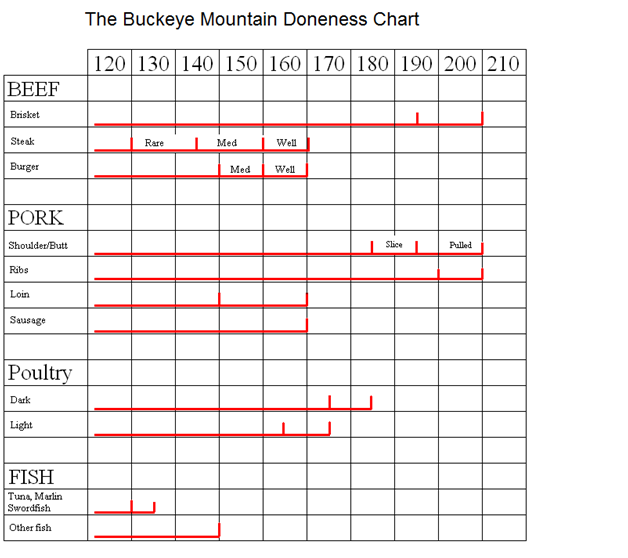Beef Steak Discussion
If you had only one meal left to eat on this earth, what would it be?
For me, a beef steak dinner would have to be it. It’s really one of the easiest things to cook.
Finding a steak worth buying is a bit harder. The same factors apply when picking out a steak or choosing a brisket. Look for hard white fat with lots of marbling. Choice or prime is best for grilling beef.

The grade is determined by the cow’s age and the amount of marbling in the muscle. The flavor of beef comes mostly from the fat, so look for a steak with lots of it. Tenderness in a steak is determined mainly from where on the animal it comes from. Leg, chest, and shoulder muscles are heavily exercised. The muscles on top (rib and back sections) are mostly just along for the ride. They don’t get much of a workout. This is where we get the tenderloins, t-bones, porterhouses, rib-eyes, etc. Since they don’t get much work, they do not develop into tough cuts like briskets (the chest). There are several ways of cooking steaks. There’s the reverse-sear, traditional method, hot-tubbing method, dirty method, etc.
I think one of the most important things to understand when cooking meat is what I call temperature shock. Take a cold cut of meat and expose it to a high temperature and one of the first things that happens is, the muscle fibers begin to contract (shrink). A muscle is made up of lots of long bundles of fibers surrounded by connective tissue (collagen). The interior of the fibers is where most of the water is stored. The more water in the fibers, the juicier the meat. The last thing we want to do is squeeze out the juices. Have you ever tossed a thin pork chop or a slice of bologna into a hot pan? If you have, you’ve seen it curl up pretty quickly. This is the reaction to high heat contracting the fibers. The same thing happens to a steak or a brisket. That’s one reason we barbeque briskets low and slow. And that’s something that we need to keep in mind when cooking our steaks.
Another important step in making a good steak is letting it rest after grilling it. When the contraction of the meat begins, it starts from the surfaces that are exposed to the heat source, and this starts to squeeze the water towards the center of the steak. Once the steak is done, a lot of the juice is concentrated in the center of the meat. Cut into it right off the grill and much of the juice will end up on the plate. Let the meat rest, the fibers loosen up; the juice is then redistributed back into the entire steak. Give it five minutes and your steak will be more tender and juicier.
Below is a chart that has some internal doneness temperatures. Remember also that there will be some carry-over cooking taking place once the meat is removed from the grill. The temp may rise a few degrees while resting, so remove the steak a few degrees short of your desired temperature.

Hot Tub Steak
This method works well for thick steaks, 1 ½ to 2 inches. Seal your steak in a plastic Ziploc bag. Put it into a bowl and fill the bowl with hot tap water. Leave it in the hot water for at least ½ hour, adding more hot water every ten minutes. While the steak is warming up in the water, get a bed of coals going, two to three layers deep. You want a hot fire. When the coals are ready, season your steaks and move them to the grill. Turn the steaks using a set of tongs (don’t use a fork) once every 60 seconds until the internal temperature is 125 degrees for a med-rare steak. Remove the steak and cover it with foil for 5 minutes before cutting into it.
Sear and Dwell
Put the steak over a hot fire. Turn it over when it has the amount of color you like
(maybe around 90 seconds) and remove it from the pit when the other side is seared to your liking. You now have a seared steak that’s still raw in the middle (unless it’s a very thin steak). You now want to cook the steak at a lower temperature so it doesn’t tighten up and the outside doesn’t get overdone. You can choke down the fire in your pit to get the temperature down to around 300, or, finish it in an oven until it reaches the desired internal temperature.
Reverse sear
The same as above except reverse the order. Cook low and slow, around 200 until the internal temp is around 110 deg. You can add some smoke to the steak with this method. Throw on a wood chunk or chips. Once you’re at 110, remove the steak and foil it up. Get the pit going as hot as you can, remove the foil and sear the meat on both sides, turning every 60 seconds until it at your desired internal temperature.
Traditional Method
I competed a few times against a bbq’er from New York. His name was Adam Perry Lang. I had heard that he won an award for being the best steak cook in the city. The strange thing is that he cooked the steaks in a strip club called The Penthouse Executive Club. Dinner and a floor show, nice. I asked him what method he used to cook his steaks. He said he turns them four times. No sear and dwell, no hot tubs. A lot would depend on how thick the steak is and the doneness you want. At home I’ve had good luck turning every 90 seconds until it’s done. Adam now runs a few BBQ joints in New York, London, and Vegas I think.
Dirty Method
I sometimes do this in the winter when I’ve got a good bed of coals going in the fireplace. Simply toss the steak into the fire, right onto the coals. Turn it a few times (use really long tongs) and brush off the ashes when you pull it out. Not many stick to the meat. Saves you from cleaning a cooking grate and impresses the heck out of your dinner guests.
Cooking times will depend on how thick the meat is and the starting temperature of your steak.
If you only remember three things, make them these:
- Let the steak come up to room temperature before you start (Set it on the counter for an hour).
- Get a good meat thermometer and check the calibration. (More on this next time)
- LET THE STEAK REST FOR AT LEAST 5 MINUTES BEFORE CUTTING INTO IT.

